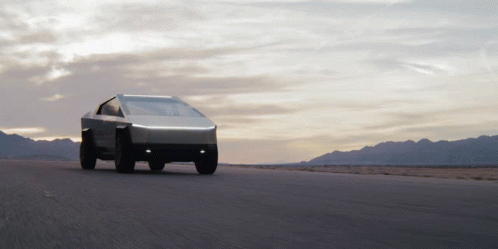From Fremont, California to Shanghai, China, Tesla is establishing a production chain that is poised to grow together with the electric vehicle movement. But with CEO Elon Musk’s announcement that Tesla was scoping out locations for a new Cybertruck Gigafactory central United States, Tesla is now seemingly getting ready to enter the Heartland of the country. That’s a place where the internal combustion engine still reigns supreme, and where Teslas are still stereotyped as vehicles that are not for the mainstream.
A Gigafactory in the center of the United States serves several purposes. Logistically, an electric vehicle facility in the area would cut down on vehicle delivery times, especially for the East Coast. It would also allow for a complete focus on the Cybertruck until Model Y production also begins at the plant. But apart from these efficiencies, Tesla’s upcoming facility also has the potential to break the final stereotypes around Tesla’s vehicles once and for all.
In a way, Tesla’s presence in the middle of America establishes the company’s footing in a section of the country that has been an evident battleground for the electric carmaker. Central United States is widely perceived as an area where Silicon Valley-style solutions such as Teslas are not effective, as places where farming, agriculture, and other hard-nosed industries do not seem compatible with the sleek, streamlined electric vehicles from the company. A big part of this is the impression that Tesla’s vehicles are only for those with money, and not for the working man.
Scouting locations for Cybertruck Gigafactory. Will be central USA.
— Elon Musk (@elonmusk) March 11, 2020
Interestingly enough, the same people who would benefit the most from a vehicle like the Cybertruck are also stereotyped as a demographic that is far from being able to “afford a Tesla.” While Tesla prices have dropped over the past few years thanks to increased battery production and manufacturing efficiencies, there is still a pervading idea that the company’s electric cars are still out of reach for most car buyers. This is, of course, untrue, with the Model 3, Model Y, and Cybertruck priced aggressively.
It has been speculated that Tesla’s new Cybertruck will need a separate production facility to keep up with demand for the vehicle. The polarizing design of the all-electric pickup with its unmistakeable stainless steel exoskeleton has already amassed an unconfirmed half-a-million reservations. Elon Musk has mentioned in the Q4 2019 earnings call that the Cybertruck is seeing a lot of demand as well.
With Tesla producing the Cybertruck in the heart of the United States, legacy automakers may find themselves surprised once more that a disruptive company has taken hold of their longtime demographic. It could, for one, end up accelerating the efforts of legacy automakers such as Ford and GM with regards to their respective electric vehicle programs. Ford will likely not give up its most loyal customers freely to the Cybertruck, after all, and the best way the veteran carmaker could rival Tesla’s pickup would be to release the Ford F-150 Electric.
There are relatively no tell-tale signs of where the Cyber Gigafactory will be built, though rumors of Nashville being a potential site are abounding. Still, one thing remains certain: the impact of a Tesla production plant in the heart of America would break through the long-lived stereotypes that innovation is confined only in places like California. It would prove that with vehicles like the Cybertruck, the electric transition is reaching all corners of the country.

News
Tesla’s most affordable car is coming to the Netherlands
The trim is expected to launch at €36,990, making it the most affordable Model 3 the Dutch market has seen in years.
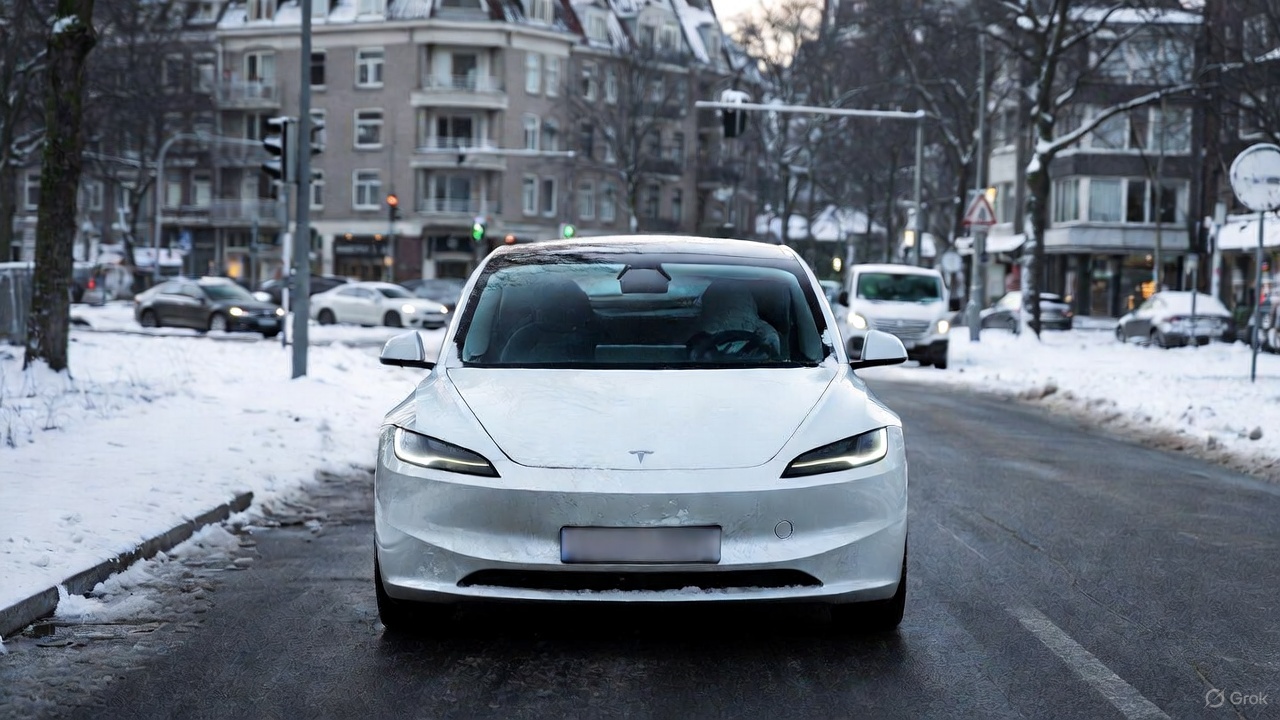
Tesla is preparing to introduce the Model 3 Standard to the Netherlands this December, as per information obtained by AutoWeek. The trim is expected to launch at €36,990, making it the most affordable Model 3 the Dutch market has seen in years.
While Tesla has not formally confirmed the vehicle’s arrival, pricing reportedly comes from a reliable source, the publication noted.
Model 3 Standard lands in NL
The U.S. version of the Model 3 Standard provides a clear preview of what Dutch buyers can expect, such as a no-frills configuration that maintains the recognizable Model 3 look without stripping the car down to a bare interior. The panoramic glass roof is still there, the exterior design is unchanged, and Tesla’s central touchscreen-driven cabin layout stays intact.
Cost reductions come from targeted equipment cuts. The American variant uses fewer speakers, lacks ventilated front seats and heated rear seats, and swaps premium materials for cloth and textile-heavy surfaces. Performance is modest compared with the Premium models, with a 0–100 km/h sprint of about six seconds and an estimated WLTP range near 550 kilometers.
Despite the smaller battery and simpler suspension, the Standard maintains the long-distance capability drivers have come to expect in a Tesla.
Pricing strategy aligns with Dutch EV demand and taxation shifts
At €36,990, the Model 3 Standard fits neatly into Tesla’s ongoing lineup reshuffle. The current Model 3 RWD has crept toward €42,000, creating space for a more competitive entry-level option, and positioning the new Model 3 Standard comfortably below the €39,990 Model Y Standard.
The timing aligns with rising Dutch demand for affordable EVs as subsidies like SEPP fade and tax advantages for electric cars continue to wind down, EVUpdate noted. Buyers seeking a no-frills EV with solid range are then likely to see the new trim as a compelling alternative.
With the U.S. variant long established and the Model Y Standard already available in the Netherlands, the appearance of an entry-level Model 3 in the Dutch configurator seems like a logical next step.
News
Tesla Model Y is still China’s best-selling premium EV through October
The premium-priced SUV outpaced rivals despite a competitive field, while the Model 3 also secured an impressive position.
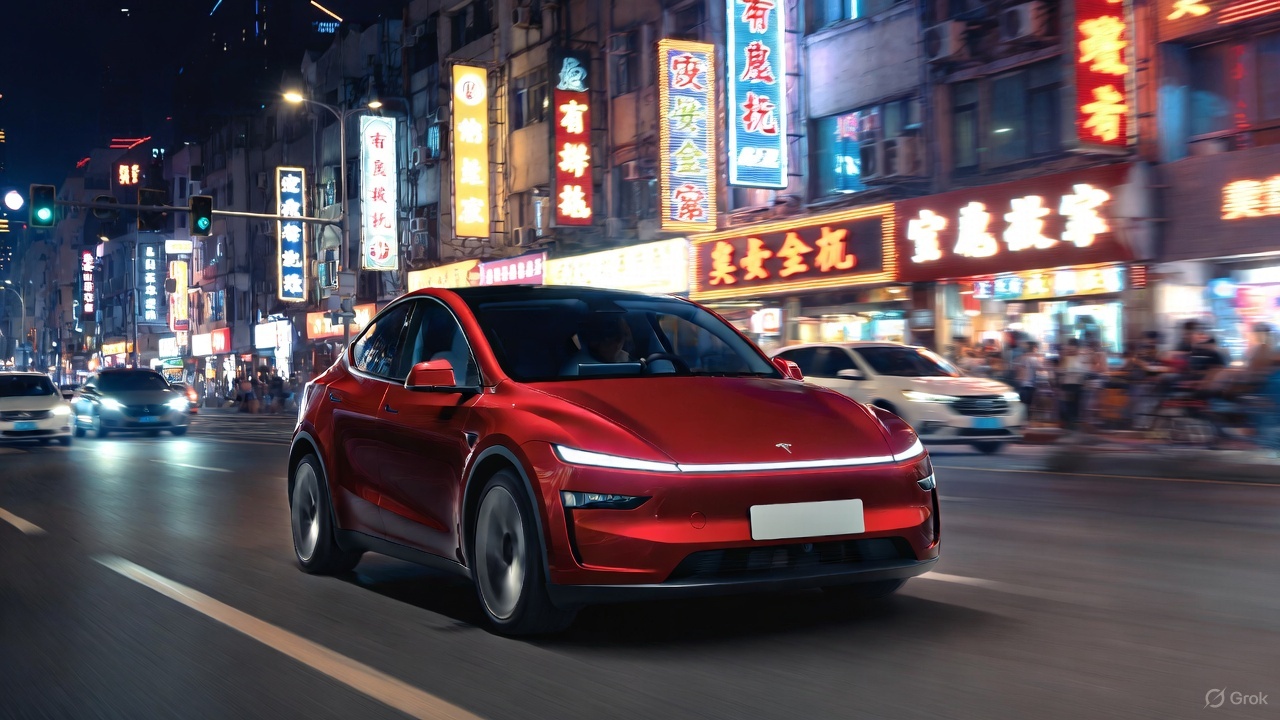
The Tesla Model Y led China’s top-selling pure electric vehicles in the 200,000–300,000 RMB segment through October 2025, as per Yiche data compiled from China Passenger Car Association (CPCA) figures.
The premium-priced SUV outpaced rivals despite a competitive field, while the Model 3 also secured an impressive position.
The Model Y is still unrivaled
The Model Y’s dominance shines in Yiche’s October report, topping the chart for vehicles priced between 200,000 and 300,000 RMB. With 312,331 units retailed from January through October, the all-electric crossover was China’s best-selling EV in the 200,000–300,000 RMB segment.
The Xiaomi SU7 is a strong challenger at No. 2 with 234,521 units, followed by the Tesla Model 3, which achieved 146,379 retail sales through October. The Model Y’s potentially biggest rival, the Xiaomi YU7, is currently at No. 4 with 80,855 retail units sold.
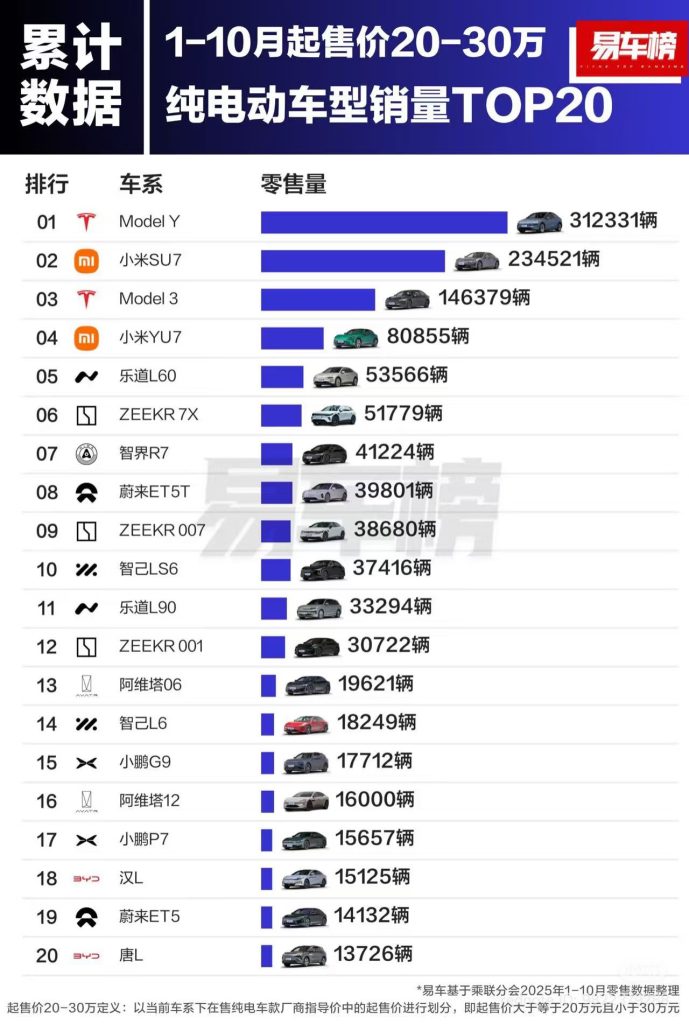
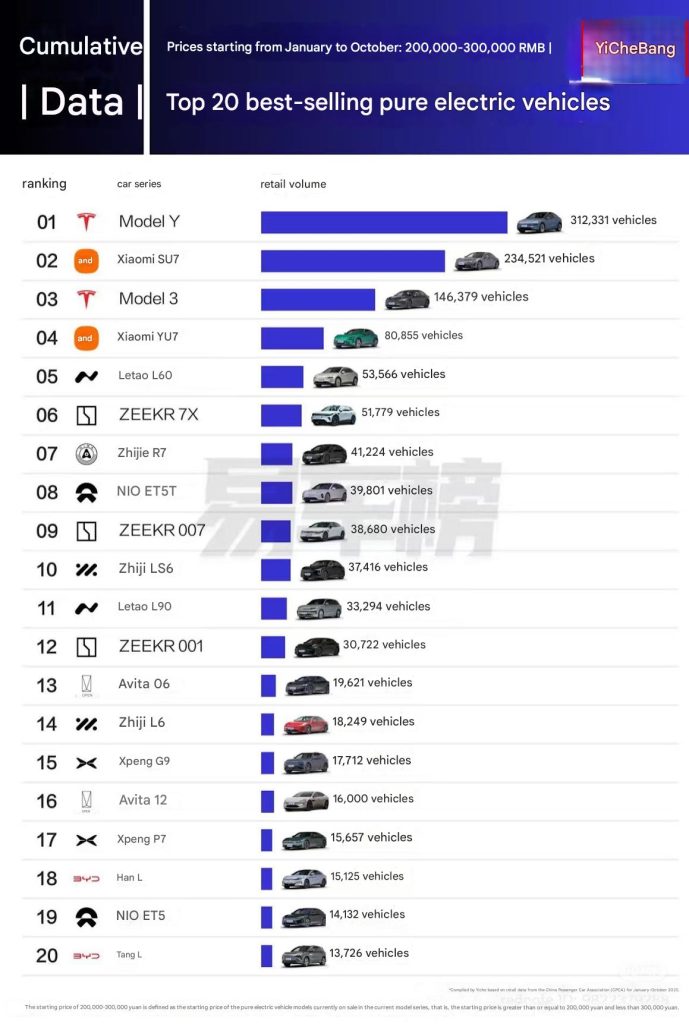
Efficiency kings
The Model 3 and Model Y recently claimed the top two spots in Autohome’s latest real-world energy-consumption test, outperforming a broad field of Chinese-market EVs under identical 120 km/h cruising conditions with 375 kg payload and fixed 24 °C cabin temperature. The Model 3 achieved 20.8 kWh/100 km while the Model Y recorded 21.8 kWh/100 km, reaffirming Tesla’s efficiency lead.
The results drew immediate attention from Xiaomi CEO Lei Jun, who publicly recognized Tesla’s advantage while pledging continued refinement for his brand’s lineup.
“The Xiaomi SU7’s energy consumption performance is also very good; you can take a closer look. The fact that its test results are weaker than Tesla’s is partly due to objective reasons: the Xiaomi SU7 is a C-segment car, larger and with higher specifications, making it heavier and naturally increasing energy consumption. Of course, we will continue to learn from Tesla and further optimize its energy consumption performance!” Lei Jun wrote in a post on Weibo.
Elon Musk
SpaceX’s Starship program is already bouncing back from Booster 18 fiasco
Just over a week since Booster 18 met its untimely end, SpaceX is now busy stacking Booster 19, and at a very rapid pace, too.
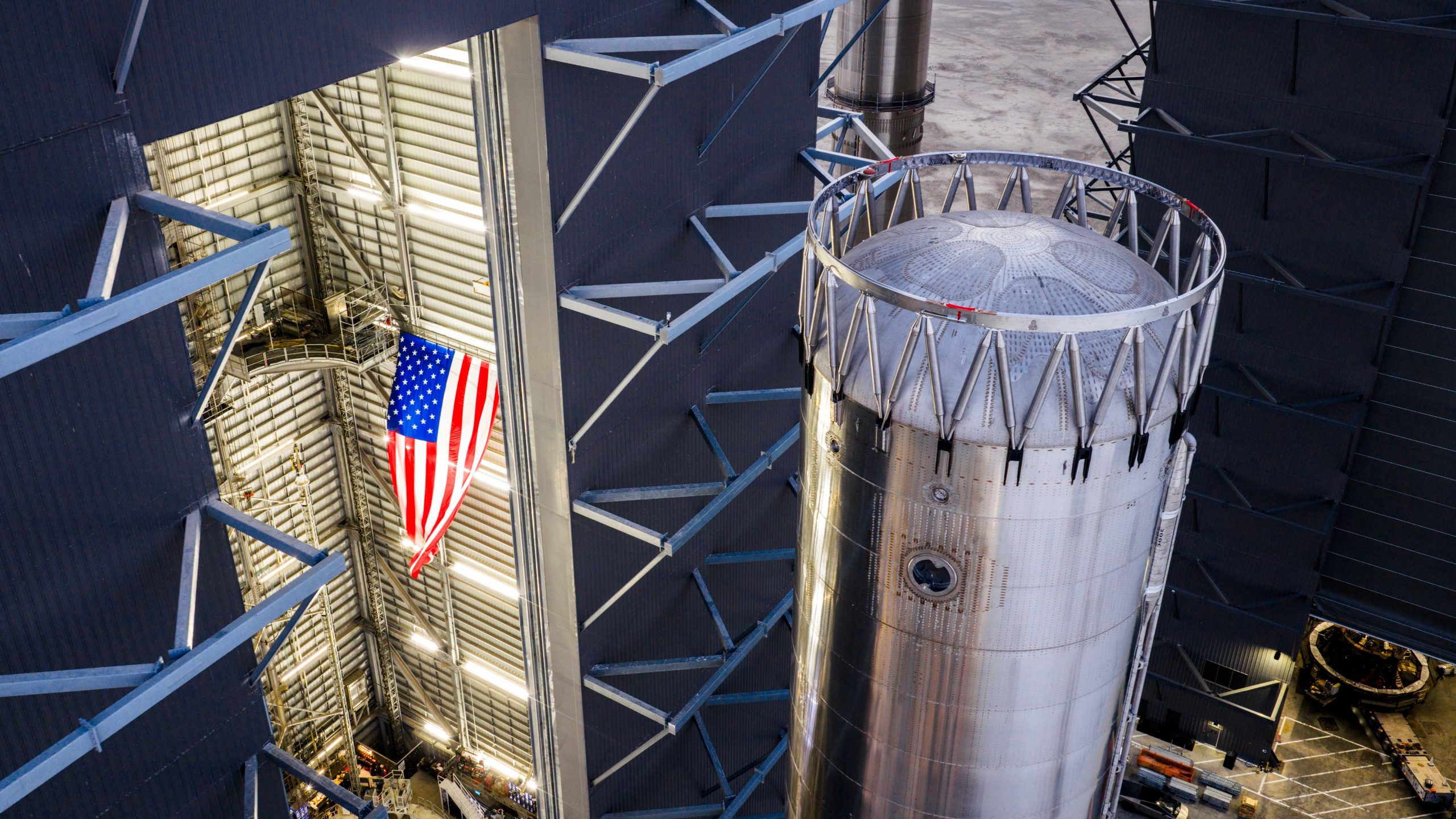
SpaceX is already bouncing back from the fiasco that it experienced during Starship Booster 18’s initial tests earlier this month.
Just over a week since Booster 18 met its untimely end, SpaceX is now busy stacking Booster 19, and at a very rapid pace, too.
Starship V3 Booster 19 is rising
As per Starbase watchers on X, SpaceX rolled out the fourth aft section of Booster 19 to Starbase’s MegaBay this weekend, stacking it to reach 15 rings tall with just a few sections remaining. This marks the fastest booster assembly to date at four sections in five days. This is quite impressive, and it bodes well for SpaceX’s Starship V3 program, which is expected to be a notable step up from the V2 program, which was retired after a flawless Flight 11.
Starship watcher TankWatchers noted the tempo on X, stating, “During the night the A4 section of Booster 19 rolled out to the MegaBay. With 4 sections in just 5 days, this is shaping up to be the fastest booster stack ever.” Fellow Starbase watcher TestFlight echoed the same sentiments. “Booster 19 is now 15 rings tall, with 3 aft sections remaining!” the space enthusiast wrote.
Aggressive targets despite Booster 18 fiasco
SpaceX’s V3 program encountered a speed bump earlier this month when Booster 18, just one day after rolling out into the factory, experienced a major anomaly during gas system pressure testing at SpaceX’s Massey facility in Starbase, Texas. While no propellant was loaded, no engines were installed, and no one was injured in the incident, the unexpected end of Booster 18 sparked speculation that the Starship V3 program could face delays.
Despite the Booster 18 fiasco, however, SpaceX announced that “Starship’s twelfth flight test remains targeted for the first quarter of 2026.” Elon Musk shared a similar timeline on X earlier this year, with the CEO stating that “ V3 is a massive upgrade from the current V2 and should be through production and testing by end of year, with heavy flight activity next year.”
Considering that Booster 19 seems to be moving through its production phases quickly, perhaps SpaceX’s Q1 2026 target for Flight 12 might indeed be more than feasible.
